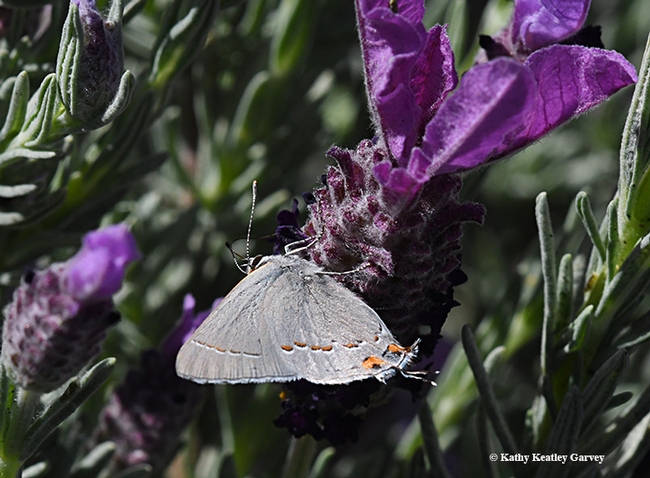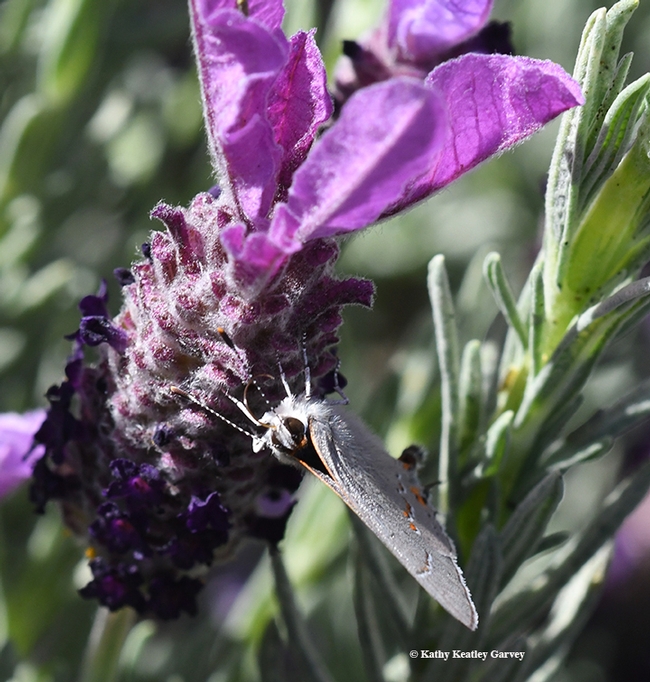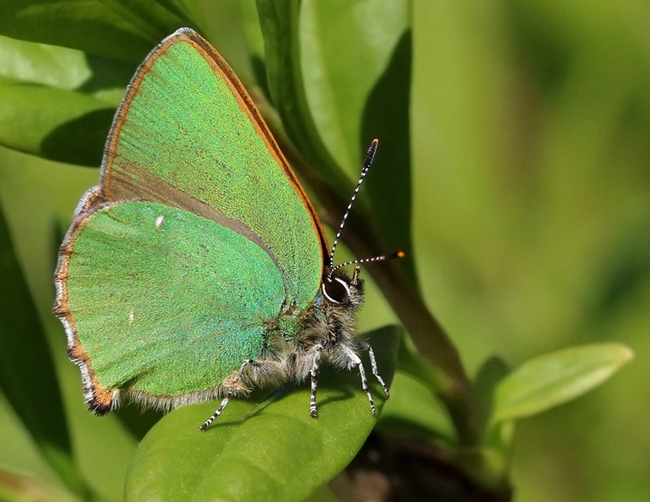You're on a winning streak when you spot a gray hairstreak.
No, not the streak in Grandpa's hair--the streak on Grandma's flowers.
It's the gray hairstreak butterfly, Strymon mellinus, also known as the common hairstreak.
Butterfly guru Art Shapiro, UC Davis distinguished professor of evolution and ecology, says the gray hairstreak does well in towns and cities in the Central Valley. "It is multiple-brooded and has a very long flight season, at sea level from February to November, but rarely seen before June in the mountains where it does not appear able to overwinter," he says on his website. "Early spring specimens are small and very dark with reduced red markings; "albinos," with the red replaced by pale yellow, occur mostly in the spring brood. There is much minor variation. Adults visit an immense variety of flowers, both wild and cultivated. They are particularly addicted to Heliotrope and white-flowered Apiaceae."
Lately we've been seeing the gray hairstreak on our Spanish lavender, although it also frequents mallows, white clover, alfalfa and other plants.
If you're into hairstreaks, be sure to check out the Green Hairstreak Butterfly Festival, a Nature-in-the-City event from 10 a.m. to 2 p.m., Saturday, April 15 at the Hoover Middle School, 2290 14th Ave., San Francisco.
We're assured that the Green Hairstreak Butterfly Festival has landed. Or maybe fluttered down...
"Spring is back and so is our local butterfly, the green hairstreak," festival organizers said. "In 2006, the community of District 7 came together to save this butterfly from disappearing. Habitat restoration and community stewardship were our main tools. Now we have a robust corridor, or butterfly highway, where we can find this nickel-sized, brightly green butterfly flying from Hawk Hill to Rocky Outcrop to the 16th Avenue Tiled Steps!"
It's a family event. Plans call for an outdoor classroom "to teach you about the butterfly, how to find it, and how to help maintain its unique habitat for all local pollinators. In addition, there will be contests, prizes, artwork, hands-on activities, access to local nature groups and plants, baked goods and crafts to take home." (Read about the Green Hairstreak corridor.)
The gray hairstreak, Strymon mellinus, and the green hairstreak, Callophrys viridis, belong to the same family Lycaenidae, which includes more than 6000 species worldwide or about 30 percent of the known butterfly species, according to Wikipedia.
Strymon, the genus name, is derived from the Strymon River in Bulgaria and Greece; the species name, melinus, means gray in Greek. The green hairstreak? Its genus name, Callophyrs, is Greek for "beautiful eyebrows" and its species name, viridis, is Latin for green.
Check out Shapiro's web page on Lycaenidae, to see other gossamer-wing family members in the Central Valley...and maybe boost your winning streak.
Attached Images:

Gray hairstreak, Strymon mellinus, nectaring on lavender in Vacaville, Calif. in April. (Photo by Kathy Keatley Garvey)

Hi, there! A gray hairsteak checks out the photographer. (Photo by Kathy Keatley Garvey)

This is a European green hairstreak (Callophrys rubi). Charles J. Sharp of Sharp Photography, UK, captured this image in Aston Upthorpe, Oxfordshire. (Photo courtesy of Wikipedia)